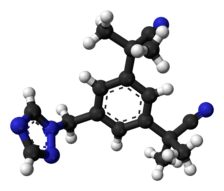Anastrozole
 | |
 | |
| Clinical data | |
|---|---|
| Trade names | Arimidex, others |
| AHFS/Drugs.com | Monograph |
| MedlinePlus | a696018 |
| License data |
|
| Pregnancy category | |
| Routes of administration | By mouth (tablets) |
| Drug class | Aromatase inhibitor; Antiestrogen |
| ATC code | |
| Legal status | |
| Legal status | |
| Pharmacokinetic data | |
| Bioavailability | 83–85% |
| Protein binding | 40% |
| Metabolism | Liver (85%) |
| Elimination half-life | 46.8 hours[2] |
| Excretion | Urine (11%) |
| Identifiers | |
| |
| CAS Number | |
| PubChem CID | |
| IUPHAR/BPS | |
| DrugBank | |
| ChemSpider | |
| UNII | |
| KEGG | |
| ChEBI | |
| ChEMBL | |
| ECHA InfoCard |
100.129.723 |
| Chemical and physical data | |
| Formula | C17H19N5 |
| Molar mass | 293.366 g/mol |
| 3D model (JSmol) | |
| |
| |
| | |
Anastrozole, sold under the brand name Arimidex among others, is a medication used in addition to other treatments for breast cancer.[1] Specifically it is used for hormone receptor-positive breast cancer.[1] It has also been used to prevent breast cancer in those at high risk.[1] It is taken by mouth.[1]
Common side effects include hot flushes, altered mood, joint pain, and nausea.[1] Severe side effects include an increased risk of heart disease and osteoporosis.[1] Use during pregnancy is known to harm the baby.[1] Anastrozole is in the aromatase-inhibiting family of medications.[1] It works by blocking the creation of estrogen.[1]
Anastrozole was patented in 1987 and approved for medical use in 1995.[4] It is on the World Health Organization's List of Essential Medicines, the most effective and safe medicines needed in a health system.[5] Anastrozole is available as a generic medication.[1] The wholesale cost in the developing world is about 1.92 to 30.60 USD a month.[6] In the United States the wholesale cost is about 3.81 USD per month.[7]
Mechanism
Anastrozole works by reversibly binding to the aromatase enzyme, and through competitive inhibition blocks the conversion of androgens to estrogens in peripheral (extragonadal) tissues.[8]
Research
The ATAC trial was of localized breast cancer and women received either anastrozole, tamoxifen, or both for five years, followed by five years of follow-up.[9] After more than 5 years the group that received anastrozole had better results than the tamoxifen group.[9] The trial suggested that anastrozole is the preferred medical therapy for postmenopausal women with localized estrogen receptor (ER) positive breast cancer.[9]
References
- 1 2 3 4 5 6 7 8 9 10 11 "Anastrozole". The American Society of Health-System Pharmacists. Archived from the original on 21 December 2016. Retrieved 8 December 2016.
- ↑ Mauras N, Bishop K, Merinbaum D, Emeribe U, Agbo F, Lowe E (August 2009). "Pharmacokinetics and pharmacodynamics of anastrozole in pubertal boys with recent-onset gynecomastia". J. Clin. Endocrinol. Metab. 94 (8): 2975–8. doi:10.1210/jc.2008-2527. PMID 19470631.
- ↑ "anastrozole". Chemical Entities of Biological Interest (ChEBI). European Molecular Biology Laboratory. Archived from the original on 2011-09-22. Retrieved 2011-08-14.
- ↑ Fischer, Janos; Ganellin, C. Robin (2006). Analogue-based Drug Discovery. John Wiley & Sons. p. 516. ISBN 9783527607495. Archived from the original on 2016-12-20.
- ↑ "WHO Model List of Essential Medicines (19th List)" (PDF). World Health Organization. April 2015. Archived (PDF) from the original on 13 December 2016. Retrieved 8 December 2016.
- ↑ "Anastrozole". International Drug Price Indicator Guide. Retrieved 8 December 2016.
- ↑ "NADAC as of 2016-12-07 | Data.Medicaid.gov". Centers for Medicare and Medicaid Services. Archived from the original on 21 December 2016. Retrieved 18 December 2016.
- ↑ Simpson ER (September 2003). "Sources of estrogen and their importance". J. Steroid Biochem. Mol. Biol. 86 (3–5): 225–30. doi:10.1016/S0960-0760(03)00360-1. PMID 14623515.
- 1 2 3 Howell A; Cuzick J; Baum M; et al. (2005). "Results of the ATAC (Arimidex, Tamoxifen, Alone or in Combination) trial after completion of 5 years' adjuvant treatment for breast cancer". Lancet. 365 (9453): 60–2. doi:10.1016/S0140-6736(04)17666-6. PMID 15639680.